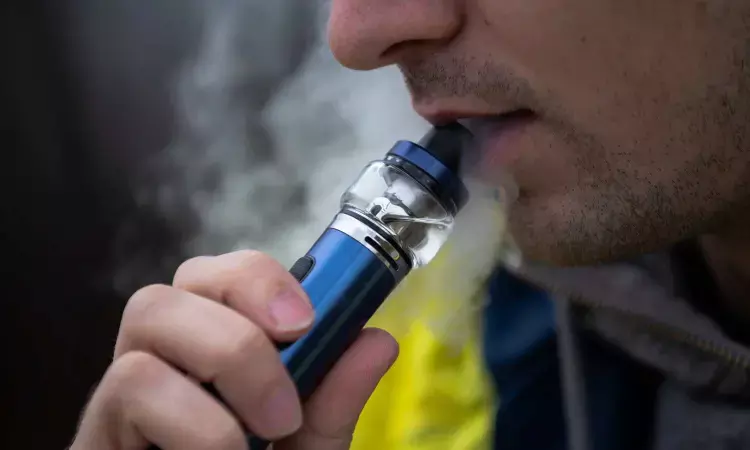- Home
- Medical news & Guidelines
- Anesthesiology
- Cardiology and CTVS
- Critical Care
- Dentistry
- Dermatology
- Diabetes and Endocrinology
- ENT
- Gastroenterology
- Medicine
- Nephrology
- Neurology
- Obstretics-Gynaecology
- Oncology
- Ophthalmology
- Orthopaedics
- Pediatrics-Neonatology
- Psychiatry
- Pulmonology
- Radiology
- Surgery
- Urology
- Laboratory Medicine
- Diet
- Nursing
- Paramedical
- Physiotherapy
- Health news
- Fact Check
- Bone Health Fact Check
- Brain Health Fact Check
- Cancer Related Fact Check
- Child Care Fact Check
- Dental and oral health fact check
- Diabetes and metabolic health fact check
- Diet and Nutrition Fact Check
- Eye and ENT Care Fact Check
- Fitness fact check
- Gut health fact check
- Heart health fact check
- Kidney health fact check
- Medical education fact check
- Men's health fact check
- Respiratory fact check
- Skin and hair care fact check
- Vaccine and Immunization fact check
- Women's health fact check
- AYUSH
- State News
- Andaman and Nicobar Islands
- Andhra Pradesh
- Arunachal Pradesh
- Assam
- Bihar
- Chandigarh
- Chattisgarh
- Dadra and Nagar Haveli
- Daman and Diu
- Delhi
- Goa
- Gujarat
- Haryana
- Himachal Pradesh
- Jammu & Kashmir
- Jharkhand
- Karnataka
- Kerala
- Ladakh
- Lakshadweep
- Madhya Pradesh
- Maharashtra
- Manipur
- Meghalaya
- Mizoram
- Nagaland
- Odisha
- Puducherry
- Punjab
- Rajasthan
- Sikkim
- Tamil Nadu
- Telangana
- Tripura
- Uttar Pradesh
- Uttrakhand
- West Bengal
- Medical Education
- Industry
Mint-flavoured e-cigarettes more liable to worsen lung function

USA: A recent study in Respiratory Research has reported that adding mint flavour to e-cigarette liquids produces more vapour particles and is linked with worse lung function in those who vape.
Researchers showed that commercially available e-cigarette liquids containing menthol generate more toxic microparticles than menthol-free juice using a specially designed robotic system that mimics the mechanics of human breathing and vaping behaviour.
An accompanying analysis of patient records from a cohort of e-cigarette smokers revealed that menthol vapers took shallower breaths and had poorer lung function than non-menthol smokers regardless of age, gender, race, pack-years of smoking and the use of nicotine or cannabis-containing vaping products.
“Many people, especially youth, erroneously assume that vaping is safe, but even nicotine-free vaping mixtures contain many compounds that can potentially damage the lungs,” said senior author Kambez H. Benam, D.Phil., associate professor in the Division of Pulmonary, Allergy and Critical Care Medicine at the University of Pittsburgh School of Medicine. “Just because something is safe to consume as food does not mean it’s safe to inhale.”
To turn young people away from vaping and curb preventable deaths, the U.S. Food and Drug Administration continues to put pressure on cigarette manufacturers to eliminate menthol in combustible tobacco products, such as regular cigarettes and cigars. But the market for vaping products worldwide continues to expand, and mint and menthol flavors remain highly popular among the 2.5 million youth who reported smoking e-cigarettes in 2022.
Because traditional toxicity testing, which involves animals or living cells grown on a flat surface, can take weeks or months to produce high-quality and clinically relevant data, regulatory bodies are struggling to keep up and test products’ safety in a timely manner.
Traditional approaches have other limitations as well. Mice and rats, animals primarily used to test aerosolized products’ safety and biological impact, have very different anatomy of their nasal passages compared to humans, which prevents them from taking an active breath through the mouth akin to taking a cigarette puff. And cell systems used for toxicity testing are either directly exposed to e-liquid on contact or are blasted with continuous aerosols that don’t account for human breathing patterns.
To improve preclinical testing of how mixing vaping liquids and adding flavorings impact vapor composition and its health effects, researchers developed a biologically inspired “vaping robot.” By precisely mimicking the temperature, humidity, puff volume and duration, this machine can simulate the pattern of healthy and diseased breathing and reliably predict lung toxicity related to e-cigarettes.
The system can measure the size and number of generated aerosolized particles and how those parameters vary depending on liquid composition. The aerosols’ effects can then be tested on engineered “lung-on-chip” devices and quickly yield high-quality data that can be used to infer potential toxicity.
In their previous research, Benam and his team found that vitamin E acetate, a common additive in cannabinoid-containing e-cigarette liquids, generates more toxic small particles that can travel deep inside the lung and wedge themselves into the narrowest airways and lining of the walls of the trachea and bronchus.
While future large-scale clinical studies are needed, the new study suggests that menthol additives could be just as dangerous as vitamin E acetate, which was strongly linked to lung injury in users of e-cigarettes and vapes.
“The main message that we want to put out there is for people, especially young adults, who haven’t smoked before,” said Benam. “Switching to e-cigarettes may be a better, safer alternative for someone who is trying to quit smoking regular tobacco products. But it’s important to have full knowledge of e-cigarettes’ risks and benefits before trying them.”
Dr Kamal Kant Kohli-MBBS, DTCD- a chest specialist with more than 30 years of practice and a flair for writing clinical articles, Dr Kamal Kant Kohli joined Medical Dialogues as a Chief Editor of Medical News. Besides writing articles, as an editor, he proofreads and verifies all the medical content published on Medical Dialogues including those coming from journals, studies,medical conferences,guidelines etc. Email: drkohli@medicaldialogues.in. Contact no. 011-43720751


